|
|
|
Published
on 27
Jun 2013
|
All rights reserved.
|
|
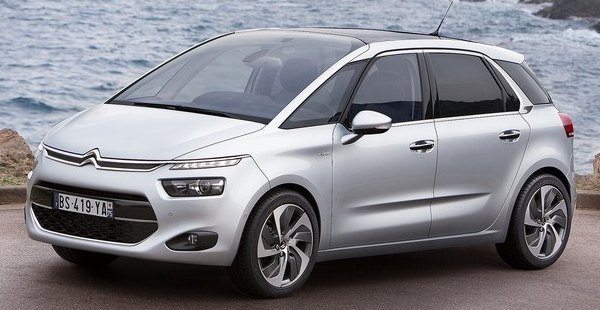
|
More compact,
lighter and more efficient. This is the new generation Citroen C4
Picasso. The outgoing C4 Picasso was popular in Europe. Even in its
final full year it still captured some 83,000 sales. However, after 7
years it inevitably got outdated in many areas and a full makeover is
desperately needed.
The new car has changed the styling direction completely. At the first
glance it looks quite weird I must say, especially the lack of
alignment among its 4 side windows and the surrounding C-shape chrome
(which is actually made of plastic). However, look closer and you will
appreciate its finer details and higher level of elegance. Its front
end design is especially tasteful. Its slim LED daytime running lights
look like an extension of the upper front grille and contribute to a
classy feel. Below them are the main headlights, which recess neatly
into the sheet metal. The subtle curves around the wheel arches and
shoulder line contribute to a sense of quality and solidity that was
absent on recent Citroen designs. At the back, pronounced taillights
with 3D graphics decorate the otherwise no-nonsense tailgate. Overall,
the new design successfully gives the C4 Picasso a premium feel.
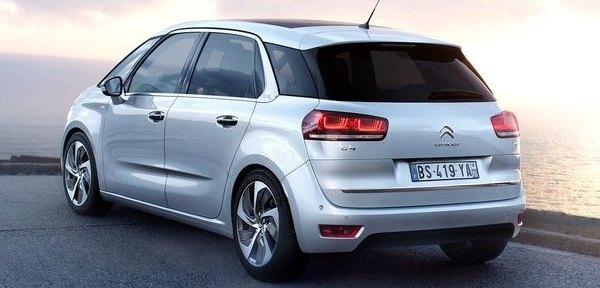
|
The new car sits on PSA's new EMP2 (Efficient Modular Platform 2)
platform. It will be the basis of all the group's C and D-segment cars,
including the forthcoming Peugeot 308 Mk2. Like Volkswagen's MQB
platform, the EMP2 emphasizes a flexible yet lightweight construction.
Its common front chassis can be mated with different rear structures
(thus allow different wheelbase and luggage space), powertrains and
suspensions (torsion beam or multi-link). The seating height is
variable, so it will allow different kinds of vehicles to be built,
like sedans, hatchbacks, SUVs, MPVs and coupes. The chassis is also
lighter, thanks to the use of high-strength steel, aluminum parts and
composite materials. Besides, the use of electric power steering,
engine auto stop-start and a smoother bottom also help reducing fuel
consumption.
On the C4 Picasso, torsion-beam rear suspension is adopted as the car
does not intend to be sporty or luxury. The rear floor and tailgate are
made of composites while the bonnet is aluminum. In addition to a
slightly more compact size, the new car is a remarkable 140 kg lighter
than the old one.
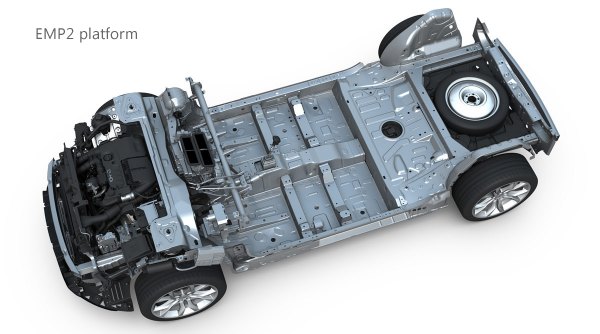
|
Measuring 4430 mm in length, 1830 mm in width and 1610 mm in height, it
is 40 mm shorter and 70 mm lower than the old car. Nevertheless, its
wheelbase is 55 mm longer at 2785 mm. This is made possible by a 70 mm
shorter front overhang. Meanwhile, front and rear tracks have been
widened by a massive 82 mm up front and 31 mm at the back. This should
improve handling. Equally useful is the fact that the engine is mounted
40-50 mm lower.
Inside, the new MPV looks pretty upmarket with its expensive plastics
(except those located at lower level) and twin-large LCDs. The upper
one is a 12-inch high-definition screen, used to display digital
instrument and driving information. The lower is a 7-inch touchscreen
for the infotainment system and climate control. It is further
supplemented with 7 touch sensitive buttons. With panoramic glass roof
and a windscreen extending well into the roof, the cabin feels
definitely spacious and airy. There is near class-leading room for both
rows. The rear row consists of 3 individual seats, each of them can
slide, fold and recline independently. This should be considered as an
advantage against its Asian rivals, whose narrower bodies do not allow
3 individual seats at the back. As expected, cargo utility is
outstanding. Its boot space is a massive 537 liters with the rear seats
in place, 40 more than before. This can be expanded to 630 liters with
the seats slide forward or 1709 liters have them folded flat onto the
floor. Besides, the front passenger seat can be folded to accommodate
longer items. You can't ask for more!
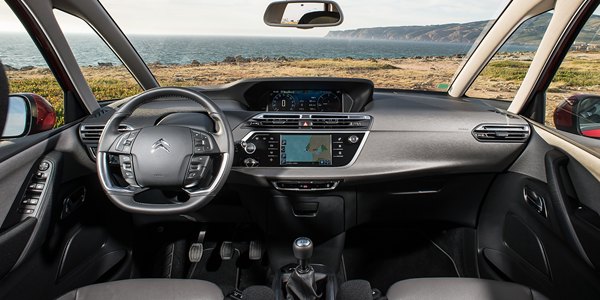
|
These days PSA doesn't have many good engines to choose from. Most
European buyers will go for the 115 hp 1.6 HDI diesel or its cheaper
version with 90 horsepower. Although the new Picasso is pretty light
for its class – at about 1300 kg – the 90 hp engine struggles to
overtake on motorway thus it is best to be forgotten. A 150 hp version
is known to be available at the end of this year, but until then the
best choice is the range-topping 1.6 THP direct injected turbo petrol
with 156 hp and 177 lbft of torque. It provides a decent blend of
flexibility and refinement, even though itself is no fireball.
Comparatively, the naturally aspirated 120 hp 1.6 VTi is much weaker.
Transmission is another weak point. While the 6-speed manual is decent,
the 6-speed automated manual is both unresponsive and unrefined,
failing to compete with rival's dual-clutch or automatic gearboxes.
Ford and Volkswagen have better powertrains.
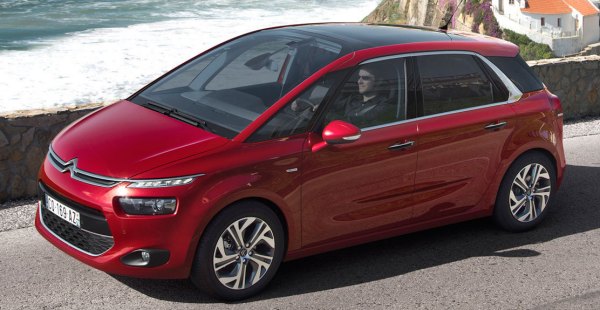
|
On the road, the Citroen MPV is pretty refined and comfortable. Its
suspension is slightly firmer than the old car but its ride quality is
still good. Noise insulation is effective, keeping the cabin free from
wind, road and engine noise when cruising on motorway. Handling is
improved from the old car, with significantly less body roll through
corners. However, it still rolls and understeers a lot more than Ford
C-Max, which is the driver's choice of the class. Its speed-sensitive
electric power steering lacks feel to inspire the driver, while the
brake pedal lacks initial bite. After all, it is still a
comfort-oriented car, just as most MPV buyers expect it to be.
Considering this is a people and cargo carrier, the new C4 Picasso
should be highly attractive. It combines an upmarket exterior and
interior, outstanding accommodation and flexibility as well as decent
performance (for 115hp HDI and 1.6THP at least) and running refinement.
Driving excitement isn't its strength, but it is already an improvement
from the old car and should be considered easily acceptable for the
class. It deserves commercial success.
|
Verdict:    
|
|
|
|
|
|
|
|
|
|
|
C4
Picasso 1.6HDi
|
2013
|
| Front-engined,
FWD |
| Steel monocoque |
Mainly steel
|
| 4428 / 1826 / 1613 mm |
| 2785 mm |
Inline-4 diesel
|
| 1560 cc |
SOHC 8 valves
|
VTG turbo
|
| CDI |
115 hp
|
210 lbft
|
6-speed manual
|
F: strut
R: torsion-beam
|
-
|
| 205/60R16 |
1298 kg
|
117 mph (c)
|
11 (est)
|
-
|
|
C4
Picasso 1.6THP
|
2013
|
| Front-engined,
FWD |
| Steel monocoque |
Mainly steel
|
| 4428 / 1826 / 1613 mm |
| 2785 mm |
Inline-4
|
| 1598 cc |
DOHC 16 valves, VVT
|
Turbo
|
| DI |
156 hp
|
177 lbft
|
6-speed manual
|
F: strut
R: torsion-beam
|
-
|
| 205/55R17 |
1296 kg
|
130 mph (c)
|
8.5 (c)
|
-
|
|
Grand
C4
Picasso 2.0HDi
|
2016
|
| Front-engined,
FWD |
| Steel monocoque |
Mainly steel
|
| 4602 / 1826 / 1638 mm |
| 2840 mm |
Inline-4 diesel
|
| 1997 cc |
DOHC 16 valves
|
VTG turbo
|
| CDI |
150 hp
|
273 lbft
|
6-speed manual
|
F: strut
R: torsion-beam
|
-
|
| 205/55R17 |
1430 kg
|
130 mph (c)
|
9.2 (c)
|
-
|
|
|
|
|
|
Performance
tested by: -
|
|
|
|
|
|
|
C4
Picasso 1.6HDi
|
2016
|
| Front-engined,
FWD |
| Steel monocoque |
Mainly steel
|
| 4438 / 1826 / 1610 mm |
| 2785 mm |
Inline-4 diesel
|
| 1560 cc |
SOHC 8 valves
|
VTG turbo
|
| CDI |
120 hp
|
221 lbft
|
6-speed manual
|
F: strut
R: torsion-beam
|
-
|
| 205/55R17 |
1320 kg
|
117 mph (c)
|
10.6 (c)
|
-
|
|
C4
Picasso 1.2 Puretech Turbo
|
2016
|
| Front-engined,
FWD |
| Steel monocoque |
Mainly steel
|
| 4438 / 1826 / 1610 mm |
| 2785 mm |
Inline-3
|
| 1199 cc |
DOHC 12 valves, DVVT
|
Turbo
|
| DI |
130 hp
|
170 lbft
|
6-speed manual
|
F: strut
R: torsion-beam
|
-
|
| 205/55R17 |
1280 kg
|
125 mph (c)
|
9.5 (c)
|
-
|
|
C4
Picasso 1.6THP
|
2016
|
| Front-engined,
FWD |
| Steel monocoque |
Mainly steel
|
| 4438 / 1826 / 1610 mm |
| 2785 mm |
Inline-4
|
| 1598 cc |
DOHC 16 valves, VVT
|
Turbo
|
| DI |
165 hp
|
177 lbft
|
6-speed automatic
|
F: strut
R: torsion-beam
|
-
|
| 205/55R17 |
1310 kg
|
130 mph (c)
|
8.1 (c)
|
-
|
|
|
|
|
|
| Performance
tested by: - |
|
|
|
|
|
|
|
|
Copyright©
1997-2016
by Mark Wan @ AutoZine
|
|